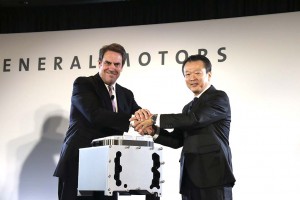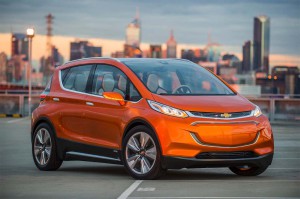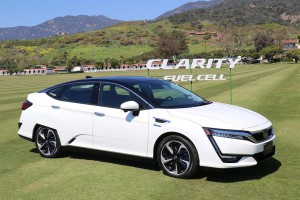
GM EVP Mark Reuss and Honda North America CEO Toshiaki Mikoshiba can celebrate again as GM and Honda are partnering on battery technology.
General Motors and Honda will team up – again – this time to work on what they hope will become the batteries powering the next generation of electric vehicles.
The agreement comes barely a year after the Detroit and Tokyo automakers announced plans to both develop and produce hydrogen fuel-cells that could be used in both vehicles and stationary power sources. The two deals reflect a significant shift in the automotive world, manufacturers increasing turning to alliances and joint ventures to help speed up the development of new technologies while also helping hold down costs.
Both GM and Honda have already announced plans to significantly expand their production and sales of electrified vehicles, including hybrids, plug-ins and pure battery-electric vehicles. The challenge is to enhance both their functionality and consumer appeal by increasing range, driving costs and reducing charging times.
“GM’s decades of electrification experience and strategic EV investments, alongside Honda’s commitment to advancing mobility, will result in better solutions for our customers and progress on our zero emissions vision,” said Mark Reuss, GM executive vice president of Global Product Development, Purchasing and Supply Chain.
(GM reveals plans to electrify fleet in China. Click Here for the story.)
The two companies didn’t reveal specifically what sort of battery chemistry they plan to focus on, though sources have indicated that both manufacturers were individually looking at technologies that would leapfrog today’s increasingly familiar lithium-ion batteries. The general consensus is that the next big breakthrough will come from a lithium variant known alternatively as lithium-air, or solid-state batteries.
That technology could have significant advantages over today’s lithium-ion batteries in terms of durability, charging time and energy density – or the amount of power that they can store. Proponents also note that by eliminating the gel material inside today’s batteries solid-state cells will be far less flammable. That’s a significant issue, as a recent, fatal Florida crash involving a Tesla Model S demonstrated. Most major airlines now ban the shipment of current lithium-ion batteries in their cargo holds.
The wording of the GM/Honda announcement suggests it may not go nearly as far as their existing fuel-cell joint venture. “Under the agreement, the companies will collaborate based on GM’s next generation battery system with the intent for Honda to source the battery modules from GM,” the statement noted. “The collaboration will support each company’s respective and distinct vehicles.”
The earlier joint venture will see the two carmakers work to further improve the latest-generation fuel-cell technology developed by Honda – which uses a version in its Clarity FCV model – and then jointly produce fuel-cell stacks at a new manufacturing facility in the Detroit suburb of Brownstown Township. The operation is set to begin production in 2020.
But, if they can achieve a real breakthrough, it could significantly improve the competitiveness of their future products. GM was the first automaker to launch an “affordable,” long-range electric vehicle, the 238-mile Chevrolet Bolt EV, which came to market months ahead of the Tesla Model 3. GM intends to launch two more long-range BEVs by mid-2019 and will have about two dozen in global showrooms by the middle of the coming decade.
(Click Here to see more about the expansion of China’s electric vehicle investment.)
Honda recently launched a shorter-range all-electric version of its Clarity, along with a plug-in hybrid version. It is rushing to launch a longer-range BEV and the company has laid out a goal of having a significant majority of its sales come from electrified models by 2030. That includes hydrogen-powered vehicles, as fuel-cell stacks use the same electric motors as battery-cars.
“In addition to our ongoing joint development and production of fuel cells, this battery component collaboration will enable us to take a new step toward the realization of a sustainable society,” said Takashi Sekiguchi, chief officer for Automobile Operations and managing officer of Honda.
The two partners are by no means the only ones racing to deliver better batteries. It has been widely speculated that Toyota may use solid-state batteries in the BEVs it will produce at a new U.S. plant as part of a partnership with Mazda. Tesla has also been working to improve its technology, along with battery partner Panasonic. And, indeed, no one in the industry wants to be left behind when the breakthrough occurs.
A study released by the Boston Consulting Group last December predicted battery prices will drop from the current $150 to 200 per kWh to $70 or less during the next five years. They could dip even more, BCG analysts noted, with solid-state or some other significant development.
Even if the GM/Honda project remains focused on relatively familiar lithium-ion chemistry, insiders report, a key goal will be reducing the amount of cobalt needed. As battery-car sales climb into the millions over the coming decade, there is growing concern that there could be a coming shortage of that critical metal.
Meanwhile, battery researchers are working to bring charging times down from hours to minutes. Even today’s LIon cells are making gains there, with the latest Level 3 charging systems able to “refill” as much as 80% of a Chevy Bolt’s range within less than an hour. BMW recently announced a super high-voltage approach that could recharge a vehicle at a rate of about 20 miles a minute.
(To see more about Honda kicking off production of two new models, Click Here.)
Meanwhile, by slashing the size and weight of a battery pack, future BEVs could push range up to levels rarely delivered by gas- and diesel-powered vehicles, proponents claim, upwards of 400 to 500 miles per charge.



Likely to work as well as the Honda powerplant in F1.